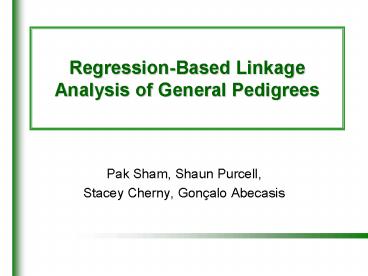Regression-Based Linkage Analysis of General Pedigrees - PowerPoint PPT Presentation
Title:
Regression-Based Linkage Analysis of General Pedigrees
Description:
Regression-Based Linkage Analysis of General Pedigrees Pak Sham, Shaun Purcell, Stacey Cherny, Gon alo Abecasis – PowerPoint PPT presentation
Number of Views:182
Avg rating:3.0/5.0
Title: Regression-Based Linkage Analysis of General Pedigrees
1
Regression-Based Linkage Analysis of General
Pedigrees
- Pak Sham, Shaun Purcell,
- Stacey Cherny, Gonçalo Abecasis
2
This Session
- Quantitative Trait Linkage Analysis
- Variance Components
- Haseman-Elston
- An improved regression based method
- General pedigrees
- Non-normal data
- Example application
- PEDSTATS
- MERLIN-REGRESS
3
- Simple regression-based method
- squared pair trait difference
- proportion of alleles shared identical by descent
4
Haseman-Elston regression
(X - Y)2
IBD
2
1
0
5
Sums versus differences
- Wright (1997), Drigalenko (1998)
- phenotypic difference discards sib-pair QTL
linkage information - squared pair trait sum provides extra information
for linkage - independent of information from HE-SD
6
- New dependent variable to increase power
- mean corrected cross-product (HE-CP)
- But this was found to be less powerful than
original HE when sib correlation is high
7
Variance Components Analysis
8
Likelihood function
9
Linkage
10
No Linkage
11
The Problem
- Maximum likelihood variance components linkage
analysis - Powerful (Fulker Cherny 1996) but
- Not robust in selected samples or non-normal
traits - Conditioning on trait values (Sham et al 2000)
improves robustness but is computationally
challenging - Haseman-Elston regression
- More robust but
- Less powerful
- Applicable only to sib pairs
12
Aim
- To develop a regression-based method that
- Has same power as maximum likelihood variance
components, for sib pair data - Will generalise to general pedigrees
13
Extension to General Pedigrees
- Multivariate Regression Model
- Weighted Least Squares Estimation
- Weight matrix based on IBD information
14
Switching Variables
- To obtain unbiased estimates in selected samples
- Dependent variables IBD
- Independent variables Trait
15
Dependent Variables
- Estimated IBD sharing of all pairs of relatives
- Example
16
Independent Variables
- Squares and cross-products
- (equivalent to non-redundant squared sums and
differences) - Example
17
Covariance Matrices
- Dependent
Obtained from prior (p) and posterior (q) IBD
distribution given marker genotypes
18
Covariance Matrices
- Independent
- Obtained from properties of multivariate normal
distribution, - under specified mean, variance and correlations
- Assuming the trait has mean zero and variance
one. - Calculating this matrix requires the correlation
between the different relative pairs to be known.
19
Estimation
- For a family, regression model is
- Estimate Q by weighted least squares, and obtain
sampling variance, family by family - Combine estimates across families, inversely
weighted by their variance, to give overall
estimate, and its sampling variance
20
Average chi-squared statistics fully informative
marker NOT linked to 20 QTL
Average chi-square
N1000 individuals Heritability0.5 10,000
simulations
Sibship size
21
Average chi-squared statistics fully informative
marker linked to 20 QTL
Average chi-square
N1000 individuals Heritability0.5 2000
simulations
Sibship size
22
Average chi-squared statistics poorly
informative marker NOT linked to 20 QTL
Average chi-square
N1000 individuals Heritability0.5 10,000
simulations
Sibship size
23
Average chi-squared statistics poorly
informative marker linked to 20 QTL
Average chi-square
N1000 individuals Heritability0.5 2000
simulations
Sibship size
24
Average chi-squares selected sib pairs, NOT
linked to 20 QTL
20,000 simulations 10 of 5,000 sib pairs selected
Average chi-square
Selection scheme
25
Average chi-squares selected sib pairs, linkage
to 20 QTL
2,000 simulations 10 of 5,000 sib pairs selected
Average chi-square
Selection scheme
26
Mis-specification of the mean,2000 random sib
quads, 20 QTL
"Not linked, full"
27
Mis-specification of the covariance,2000 random
sib quads, 20 QTL
"Not linked, full"
28
Mis-specification of the variance,2000 random
sib quads, 20 QTL
"Not linked, full"
29
Cousin pedigree
30
Average chi-squares for 200 cousin pedigrees, 20
QTL
Poor marker information Poor marker information Full marker information Full marker information
REG VC REG VC
Not linked 0.49 0.48 0.53 0.50
Linked 4.94 4.43 13.21 12.56
31
Conclusion
- The regression approach
- can be extended to general pedigrees
- is slightly more powerful than maximum likelihood
variance components in large sibships - can handle imperfect IBD information
- is easily applicable to selected samples
- provides unbiased estimate of QTL variance
- provides simple measure of family informativeness
- is robust to minor deviation from normality
- But
- assumes knowledge of mean, variance and
covariances of trait distribution in population
32
Example Application Angiotensin Converting
Enzyme
- British population
- Circulating ACE levels
- Normalized separately for males / females
- 10 di-allelic polymorphisms
- 26 kb
- Common
- In strong linkage disequilibrium
- Keavney et al, HMG, 1998
33
Check The Data
- The input data is in three files
- keavney.dat
- keavney.ped
- keavney.map
- These are text files, so you can peek at their
contents, using more or notepad - A better way is to used pedstats
34
Pedstats
- Checks contents of pedigree and data files
- pedstats d keavney.dat p keavney.ped
- Useful options
- --pairStatistics Information about relative
pairs - --pdf Produce graphical summary
- --hardyWeinberg Check markers for HWE
- --minGenos 1 Focus on genotyped individuals
- What did you learn about the sample?
35
Regression Analysis
- MERLIN-REGRESS
- Requires pedigree (.ped), data (.dat) and map
(.map) file as input - Key parameters
- --mean, --variance
- Used to standardize trait
- --heritability
- Use to predicted correlation between relatives
- Heritability for ACE levels is about 0.60
36
MERLIN-REGRESS
- Identify informative families
- --rankFamilies
- Customizing models for each trait
- -t models.tbl
- TRAIT, MEAN, VARIANCE, HERITABILITY in each row
- Convenient options for unselected samples
- --randomSample
- --useCovariates
- --inverseNormal
37
The End































